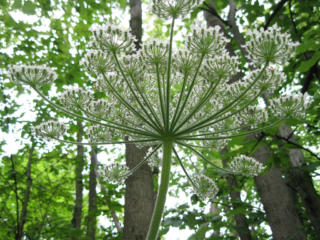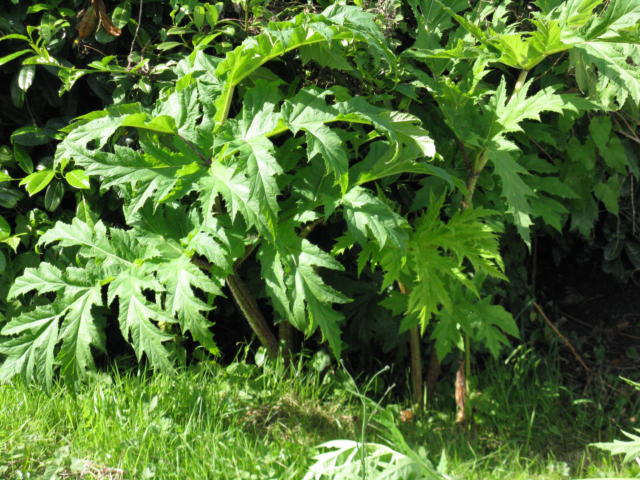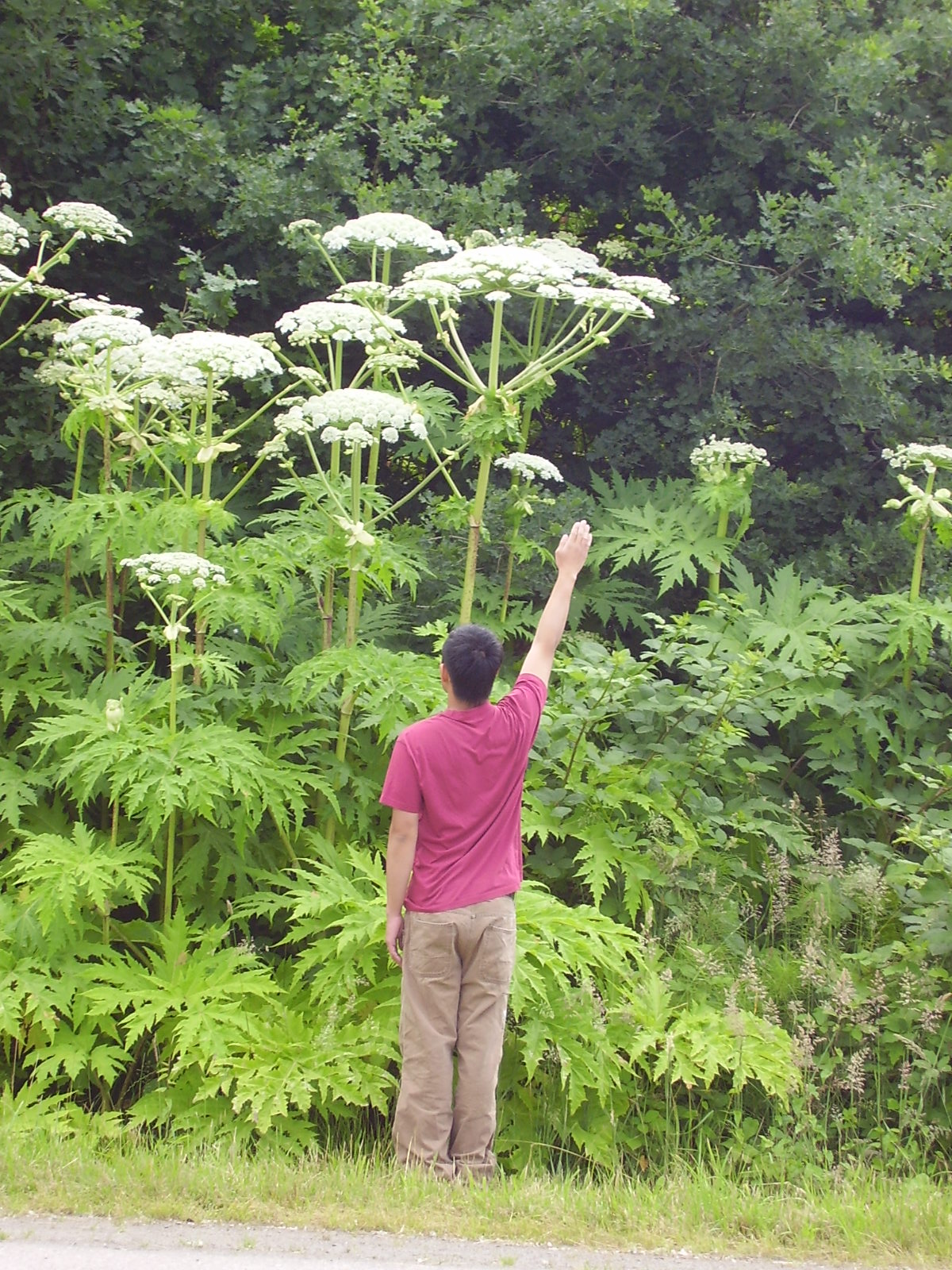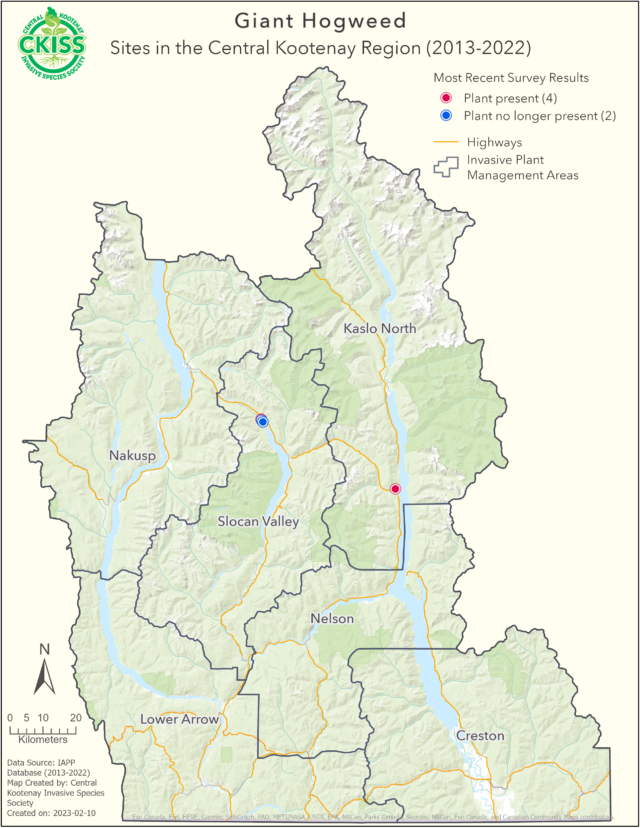Heracleum mantegazzianum
Caution: This plant has toxic sap which can cause skin burns.
Description

- Very tall (up to 5.5 m when in flower), short-lived perennial in the Carrot family. Resembles native Cow Parsnip, but is much larger in size and has more serrated leaves.
- Stalks are thick and hollow, covered with reddish-purple flecks and stiff hairs.
- Leaves are very large and dark green, with deeply incised lobes and coarse teeth on all margins. Hairs on underside are stiff and stubby.
- Forms large, white, umbrella-shaped flower clusters from June to August. Flower clusters can be 1 meter in diameter!
- Reproduces by seed only.
- Prefers damp, rich soil, and can grow vigorously in various light conditions including full shade.
- Most commonly found in ditches, wetlands, riparian areas, wooded ravines, roadsides, and other disturbed sites.

Introduction and spread
- Introduced from Asia by humans as a horticultural curiosity.
- Each plant can produce up to 100,000 winged seeds that can float for up to 3 days, and can remain viable for up to 15 years.
- Seeds can be dispersed in wind, flowing water, and by inadvertent animal/human transport when seeds adhere to fur, clothing, or equipment.
Consequences of invasion
- Health Risk: Sap (found in leaves, stalks, and stem hairs) contains toxins that can cause severe skin inflammation and painful burns if affected skin is exposed to sunlight. Scars can persist for many years. WorkSafeBC has issued a special Toxic Plant Warning for this species.
- Ecological Impact: Out-shades and out-competes native species, and reduces biodiversity in its preferred habitat. Shallow root system reduces soil stability compared to healthy native plant complex, and increases erosion hazard on steep terrain and stream banks.

Status in the CKISS region
- Giant hogweed is classified as Eradicate on the CKISS Annual Priority List.
- It has only been detected in the Kaslo and Slocan Invasive Plant Management Areas of our region.
- Because of its limited distribution, eradication is feasible. CKISS is working to eradicate this plant from these sites and prevent it from spreading to new areas.
- Please report any findings of this species immediately.
- To learn more about how CKISS classifies and manages invasive species, see our Invasive Species Priority Lists page.
Integrated pest management options
Prevention
- Report sightings of this species
- Be Plantwise – Choose non-invasive or native plants for your garden, and do not transplant unknown plants into new sites.
- Practice PlayCleanGo: arrive and leave natural areas clean. Remove all dirt, plants, seeds, and bugs from your equipment, pets, footwear, and clothing. Stay on existing trails, and avoid weed-infested areas.
- Dispose of garden waste responsibly, by bagging and transporting to a designated disposal site (e.g. landfill). Do not dump garden waste in natural areas
Mechanical control
**Safety alert**
Anyone handling Giant Hogweed parts should wear waterproof gloves and outerwear, as well as safety glasses to protect skin from toxic sap. Refer to WorkSafeBC’s Toxic Plant Warning for more details.
- Mature plants: manually remove the first 8 – 12 cm of the central root.
- Immature plants: mow every 2 weeks to exhaust the seed bank in the soil; this could take 3 – 5 years.
- Disposal: bag and dispose at the landfill, or dry and burn all plant parts. DO NOT COMPOST! Warning: take special care when controlling Giant Hogweed near waterbodies to prevent the movement of plant parts downstream.

Biocontrol
- There are no effective biological control agents available for Giant Hogweed.
Chemical control
- Before considering herbicide use, site characteristics and objectives must be evaluated. Herbicide labels and pesticide regulations must be reviewed and followed. Herbicides must never be used within 10 m of any waterbody.
- Contact a certified pesticide applicator in your area to determine whether this is a suitable option for you.
- Application of pesticides on Crown land must be carried out following an approved Pest Management Plan and under the supervision of a certified pesticide applicator (Integrated Pest Management Act).
Invasive giant hogweed vs native cow’s parsnip: What is the difference?
- We have been receiving many reports of Giant Hogweed in the area. Thanks very much for your reports! To date, all reports have been identified as cow parsnip (Heracleum maximum), a common native plant species.
- You can watch the video below and read the CKISS blog post on this topic to assist you in determining the difference between these plants.
- If you think you have found giant hogweed, please report it!


